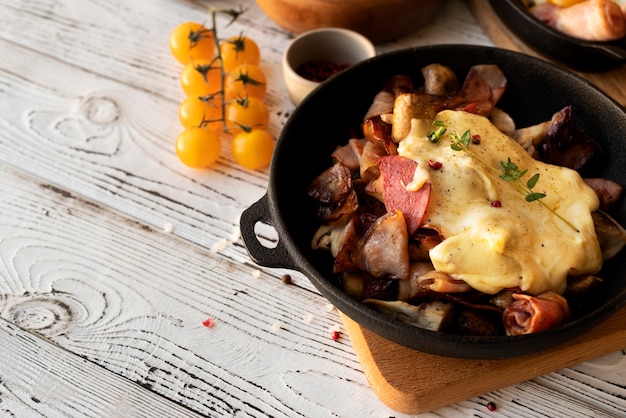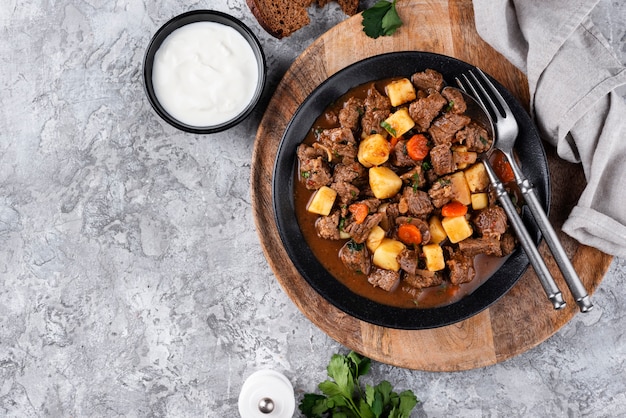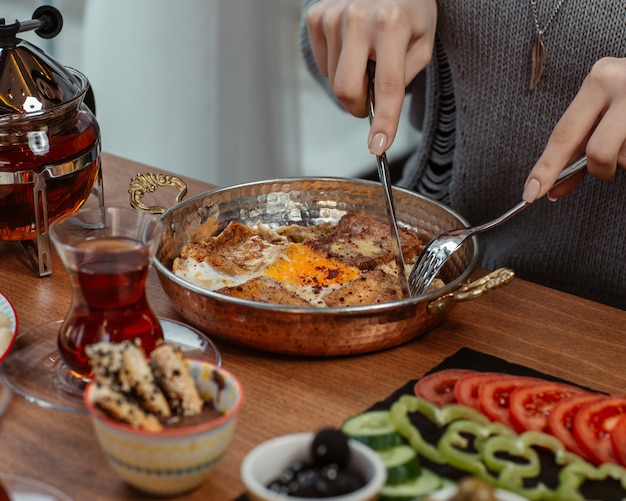You know that feeling, right? The chill in the air, the leaves turning, and the craving for a comforting, soul-warming meal. There's nothing quite like a good beef stew to chase away the autumn blues, and I'm here to share all my secrets to making it absolutely perfect. Forget the fancy culinary terms and complicated techniques – we're keeping it simple, straightforward, and utterly delicious.
This guide will walk you through every step, from choosing the right cut of beef to perfecting that velvety gravy. We'll uncover the magic of slow cooking, explore the world of flavour combinations, and even tackle some common pitfalls that can turn your stew from a triumph to a tragedy. By the time you're done, you'll be a bona fide beef stew master, capable of whipping up a dish that'll have your loved ones begging for seconds.
(Part 1) The Beef: The Foundation of Your Stew

Choosing the Cut: A Tough But Tender Choice
Let's face it, the beef is the star of the show. You can't just throw any old piece in and expect a masterpiece. You need a cut that's tough enough to hold its own during the long cooking process, but tender enough to melt in your mouth afterwards. My personal go-to is a chuck roast. It's marbled with fat, which adds flavour and keeps everything juicy. Think of it like a steak that's been given a chance to really relax and unwind.
But if you're feeling adventurous, explore other options like a brisket or a shoulder clod. Each cut offers a slightly different texture and flavour profile, so don't be afraid to experiment.
Preparing the Beef: Building Flavor from the Start
Once you've got your beef, it's time to give it a little makeover. A good old-fashioned browning is the secret to unlocking a rich, deep flavour. Think of it like giving your beef a little tan. Heat some oil in a large pan over a medium-high heat, then sear the beef on all sides. Don't worry about cooking it all the way through, just get that beautiful golden crust. This step creates a barrier that traps the juices inside, ensuring a tender and flavorful result.
(Part 2) The Vegetables: A Symphony of Textures and Flavors

A Cast of Characters: The Vegetable Lineup
Now it's time to assemble the supporting cast – the vegetables! This is where you can really let your creativity shine. There are the classics, of course, like carrots, potatoes, and onions. They're like the reliable friends you always invite to a party. But don't be afraid to bring in some new faces. I love adding celery, parsnips, or even a few mushrooms for an earthy depth of flavour.
Cutting and Preparing: Making Sure Everything Cooks Evenly
The size of your vegetable chunks matters. If they're too big, they'll be undercooked and tough. If they're too small, they'll disintegrate into mush. I prefer to cut everything into bite-sized pieces, ensuring even cooking. Remember to peel those potatoes – nobody wants a mouthful of skin in their stew.
(Part 3) The Liquid: The Heart and Soul of Your Stew

The Base: Beef Stock or Red Wine?
Now we're getting to the heart of the matter – the liquid that will bring your stew together. I'm a stickler for using beef stock, it's like giving your stew a warm hug. But you can also use red wine, or even a combination of the two. The important thing is to use good quality – you don't want to water down your flavours with something bland.
Adding Depth of Flavour: Herbs and Spices
Don't underestimate the power of herbs and spices. A good bay leaf is a must, adding a touch of earthy sweetness. I'm a big fan of thyme, rosemary, and a pinch of pepper. You can also add a touch of sweetness with a tablespoon of brown sugar or a splash of Worcestershire sauce. Don't be afraid to experiment and find your own perfect blend.
(Part 4) The Slow Cooking Process: Transforming Tough to Tender
The Magic of Slow Cooking: Time and Patience
This is where the magic happens – the slow and gentle cooking that transforms tough beef into melt-in-your-mouth tenderness. Think of it as a spa day for your beef. A dutch oven is ideal for this, but a slow cooker or a large pot on the stovetop will also do the trick.
Setting the Stage: From Browning to Simmering
First, sear your beef. Remember that golden crust? That's where the flavour is. Then add your vegetables and any other seasonings. Pour in your stock or wine, and bring the whole thing to a simmer. Now, the crucial part: cover it tightly and let it cook for a good 2-3 hours, or until the beef is fork-tender.
(Part 5) The Gravy: The Finishing Touch That Makes All the Difference
Building a Delicious Base: The Power of Stock and Wine
After all that simmering, you'll be left with a glorious stew, but it's not quite ready for the table yet. It's time to create the perfect gravy, the crowning glory of any good stew. Think of it as a luxurious silk scarf for your stew.
Thickening and Richness: The Art of Flour or Cornflour
You can thicken your gravy a few different ways. My go-to method is to whisk in a tablespoon or two of flour, or cornflour, into a little bit of the cold stock. This creates a smooth slurry that won't clump up when you add it to the hot stew. Then slowly whisk that mixture into the hot stew, stirring until it thickens to the desired consistency.
(Part 6) Serving and Enjoying: The Moment of Truth
The Grand Finale: Spooning Up Perfection
The moment you've been waiting for! Your beef stew is ready to be devoured. Spoon it into bowls, and top with some fresh parsley for a touch of colour and flavour.
The Perfect Accompaniment: Crusty Bread, Sour Cream, or Greek Yoghurt
A warm loaf of crusty bread is an absolute must. Dip those chunks of bread into the rich gravy, and you've got yourself a taste sensation. If you're feeling extra fancy, add a dollop of sour cream or Greek yoghurt on top.
(Part 7) Tips and Tricks: Making Your Stew Unique
Adding Your Personal Touch: Flavour Combinations are Endless
You've got the basic recipe down, but there are endless ways to personalize your stew. Love a bit of heat? Add a pinch of cayenne pepper or a spoonful of chili flakes. Feeling adventurous? Try adding a handful of dried cranberries or a splash of balsamic vinegar. Let your taste buds be your guide!
Freezing for Later: Stew for the Future
Want to save yourself some time later? No problem. Simply let your stew cool completely, then transfer it to airtight containers and freeze for up to 3 months. When you're ready to enjoy it, just defrost it in the fridge overnight and reheat it on the stovetop.
(Part 8) Common Mistakes to Avoid: Stew Pitfalls to Watch Out For
Overcooked Vegetables: Nobody Wants Mush
Nobody wants mushy vegetables in their stew. Make sure you don't overcook them. Add the tougher vegetables, like carrots and potatoes, earlier in the cooking process, and add the more delicate ones, like peas and spinach, towards the end.
Too Much Liquid: A Watery Disaster
This is a common problem. Adding too much liquid can result in a watery stew, which is not ideal. Start with a smaller amount of liquid and adjust as needed. Remember, you can always add more, but you can't take it away.
Undercooked Beef: Tough and Chewy
You want your beef to be fall-apart tender, so don't rush the cooking process. If you're unsure whether it's cooked enough, simply prick it with a fork. If it goes in easily, it's ready!
Adding the Gravy Too Early: Lumpy Disaster
Adding the flour slurry too early in the cooking process will result in a lumpy gravy. Wait until the end, when the stew has finished simmering, before you whisk in the thickener.
(Part 9) FAQs: Frequently Asked Questions About Beef Stew
1. Can I Use Different Cuts of Beef?
Absolutely! You can use a variety of cuts, including brisket, chuck roast, shoulder clod, or even short ribs. Just make sure it's a tougher cut that will hold up well during the long cooking process.
2. Can I Make the Stew in a Slow Cooker?
Yes, you can definitely make it in a slow cooker. Simply follow the same instructions, but transfer the ingredients to the slow cooker and cook on low heat for 6-8 hours, or on high heat for 3-4 hours. The slow cooker does all the work for you!
3. What if I Don't Have Beef Stock?
If you don't have beef stock, you can use red wine, chicken stock, or even water. Just remember that the flavour will be different.
4. How do I Know if My Beef is Cooked?
The beef should be fork-tender and easily shredded. If it's still tough, cook it for another 30-60 minutes. A little extra time is always better than a tough piece of meat.
5. Can I Add Other Ingredients to My Stew?
Absolutely! You can add anything you like. A few other ideas include:
Bacon or pancetta: Adding some smoky bacon or pancetta will add another layer of flavour and richness.
Mushrooms: Mushrooms add a wonderful earthy and umami flavour to the stew.
dried beans: Dried beans, such as kidney beans or chickpeas, add a hearty and protein-packed texture to the stew.
Peppers: bell peppers or chili peppers can add a touch of sweetness or heat to the stew.
Celery: Celery adds a fresh and crunchy element to the stew.
Parsnips: Parsnips add a subtle sweetness and a lovely golden colour to the stew.
(Part 10) The Final Word: Embrace the Joy of Cooking
There you have it, folks! Your ultimate guide to making the most delicious beef stew. Remember, cooking is all about experimentation. Don't be afraid to tweak the recipe and make it your own. And most importantly, have fun! Enjoy the process, savour the aromas, and relish the satisfaction of creating a meal that warms both the body and the soul. Happy stewing!
Everyone is watching

Perfect Rice Every Time: The Ultimate Guide to Cooking Rice
Cooking TipsAs a self-proclaimed foodie, I've always been a bit obsessed with rice. It's the foundation of countless cuisi...

Prime Rib Roast Cooking Time Chart: Per Pound Guide
Cooking TipsPrime rib roast. Just the name conjures images of lavish dinners, crackling fires, and hearty laughter. It’s ...

The Ultimate Guide to Cooking Asparagus: Tips, Techniques, and Recipes
Cooking TipsAsparagus. The mere mention of this spring delicacy conjures up images of vibrant green spears, crisp and burs...

Ultimate Guide to Cooking the Perfect Thanksgiving Turkey
Cooking TipsThanksgiving. Just the word conjures up images of overflowing tables laden with delicious food, the scent of r...

How Long to Bake Potatoes in the Oven (Perfect Every Time)
Cooking TipsBaked potatoes are a staple in my kitchen. They're incredibly versatile, delicious, and surprisingly easy to m...
